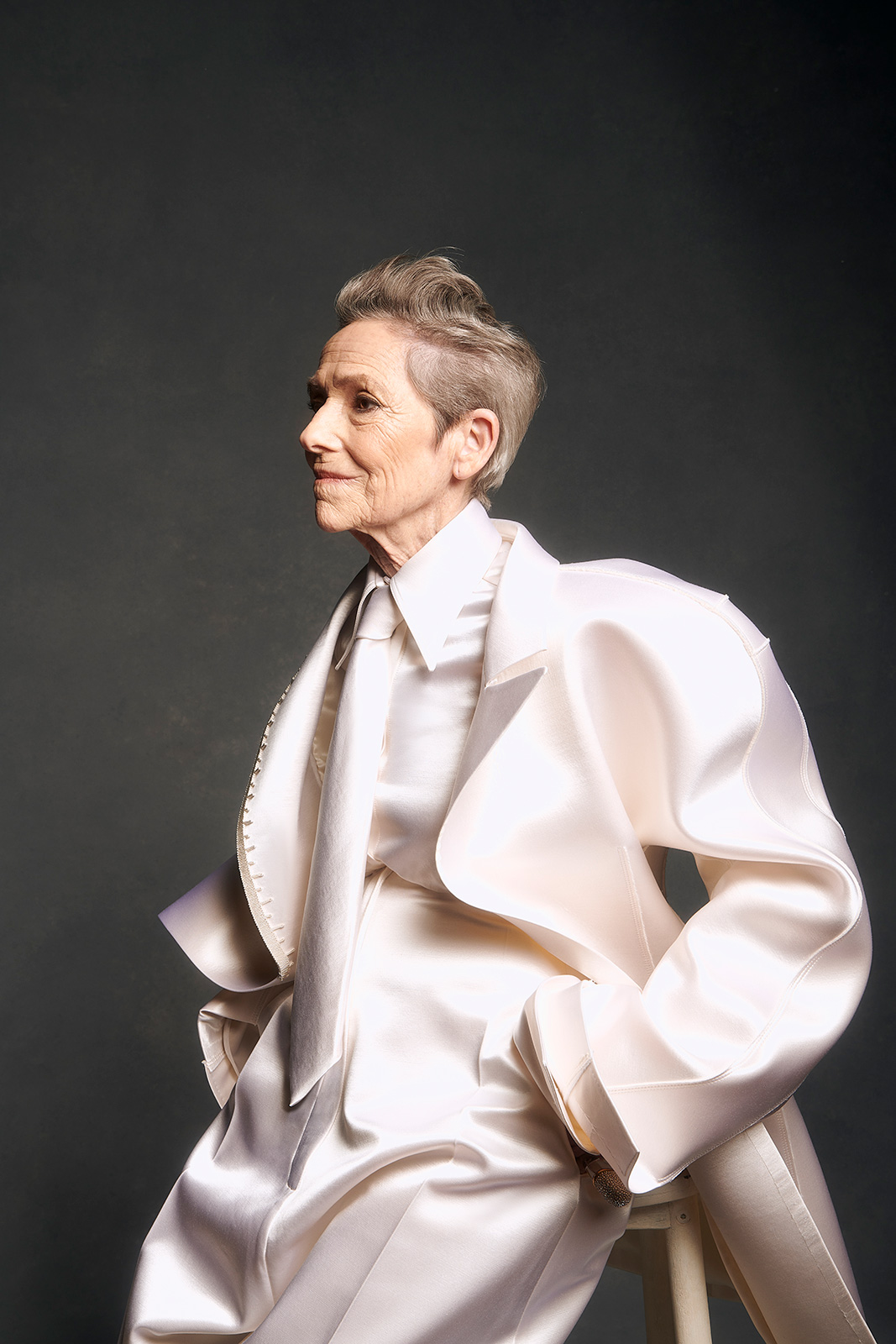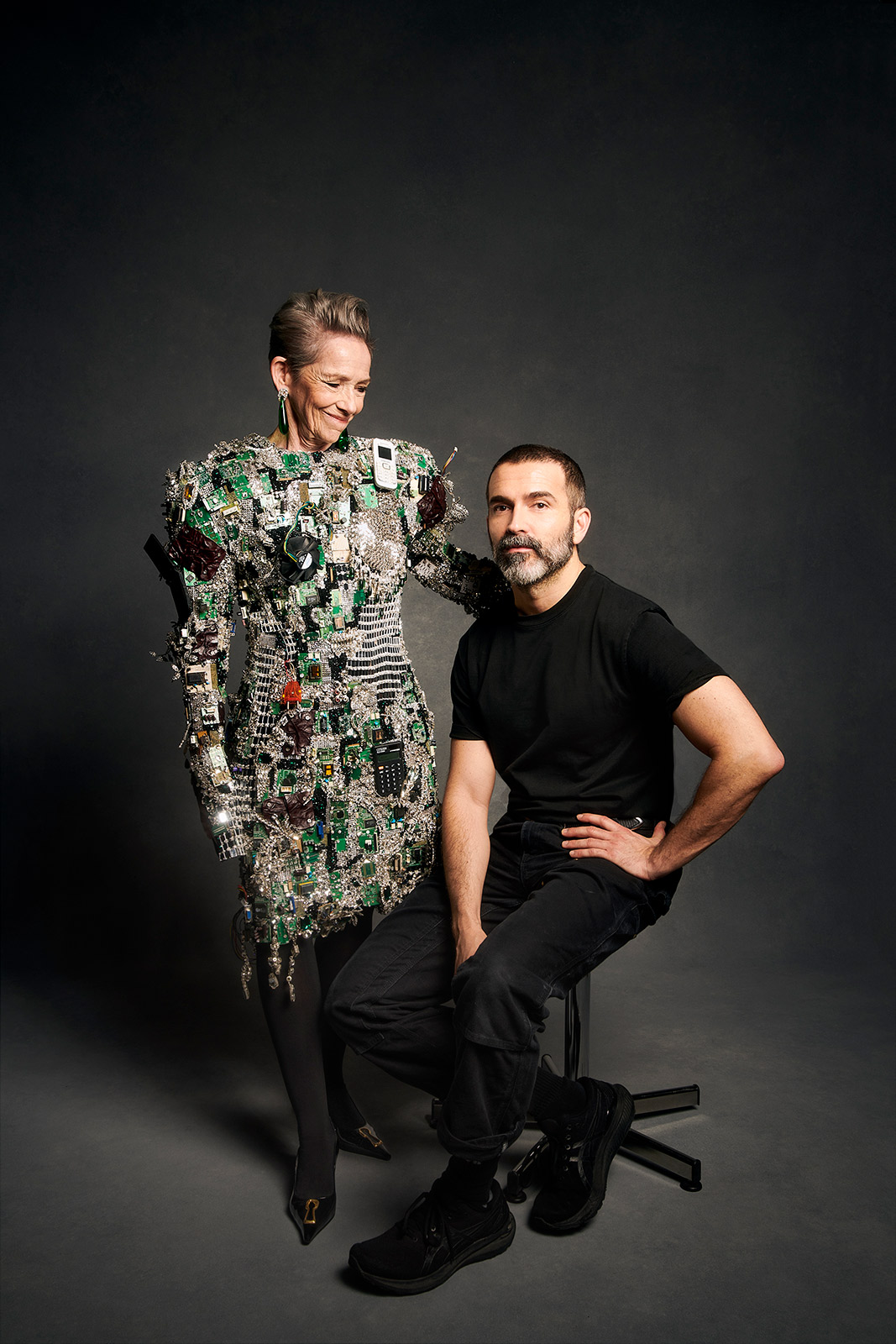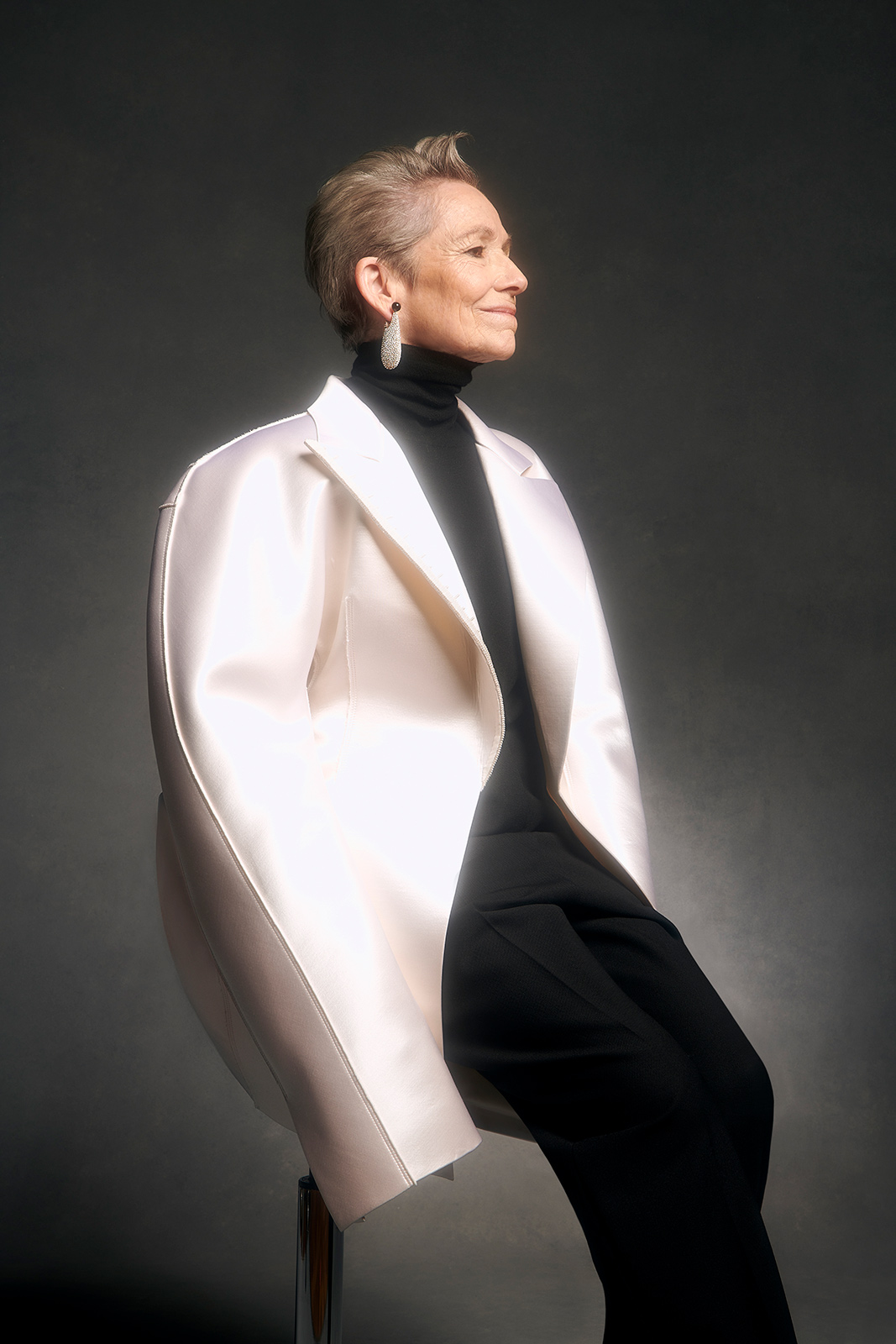Fashion Critic-at-Large Katharine K. Zarrella gets to the heart of sartorial scripture with the mother and son for Document’s Spring/Summer 2024 issue
“Any time the work can be worn beyond the runway is so gratifying,” said Daniel Roseberry, the American artistic director of Paris-based fashion house Schiaparelli. Since being hired in 2019, Daniel, who was previously head of design at Thom Browne, has designed handbags adorned with nipples, leather bodysuits hand-painted with female anatomy, and dresses brandishing trompe l’oeil breasts. “And making the choice to wear a t-shirt with boobies on it says something about who you are.”
Among the biggest fans of his boobie-emblazoned garments, rib cage-embellished suiting, and other subversive-luxe designs is his mother, Fran Roseberry, an artist and calligrapher who lives in Daniel’s hometown of Plano, Texas. “I was out the other day and a woman stopped me and asked, ‘Is that a Schiaparelli bag?’” Fran recalled. “And I said, ‘Yes! And you’ve got to see my wallet!’ It was the one with the nipple piercing.”
When aristocrat-turned-designer Elsa Schiaparelli founded her namesake brand in Paris in the late 1920s, she collaborated with surrealist masterminds including Salvador Dalí to create a dress adorned with a subversive lobster (worn by Wallis Simpson), a shoe-shaped hat, and a black gown with subtle protrusions that mimicked the human skeleton.
“Designing for me incidentally is not a profession but an art,” Schiaparelli—or Schiap, as her friends called her—wrote in her 1954 memoir Shocking Life. It’s fitting, then, that Daniel’s practice is so profoundly informed by art, particularly drawing, in which his mother tutored him as a child. “She introduced me to a natural method I could adapt to the rest of my creative life,” he said.
Daniel’s father is a celebrated Anglican minister whose sermons he’d devour in church every Sunday. Those who’d assume growing up in a deeply Christian home was creatively stifling would be wrong. Daniel’s parents passionately encouraged his artistic pursuits, even when he’d sit in Sunday service sketching Jessica Rabbit and Michelle Pfeiffer’s leather-clad Catwoman.
“I always had my own dialogue with God, and that has not changed,” said Daniel. “Faith is a creative process.” Here, the designer and his mother-muse discuss fashion, religion, and nipple blouses in God’s house.
“We’re Christians and my husband’s a clergyman, so we believe that God creates all of us with unique gifts, but we recognized that Daniel’s gifts were exceptional the first time we noticed him drawing.”
Katharine K. Zarrella: Daniel, how did your mom nurture your creativity when you were a child?
Daniel Roseberry: Before I could even talk I was reaching for pens or pencils. I’ve been doodling ever since. Mom was the only person who really knew how to cultivate the passion that was starting to creep in. A lot of that was teaching me how to work through my frustrations. So much of my drawing life when I was a kid was learning how to deal with disappointment. When you’re in the creative industry, and especially when you’re working with teams of people who don’t see what you see, so much of it is about bringing people on board with your vision and working through it. The creative process can be agony and also ecstasy. Patience is important. That’s one of the major lessons I took away from my time [drawing] with Mom.
Fran Roseberry: Dealing with a mistake or frustration is its own creative process. You either start over or you work through it.
It might make me cry to talk about this, but one of Daniel’s strengths is that he is so teachable. He wants to learn and he’s not afraid to ask for help. And I think what’s rolled up in that is a humility about who he is and this gift he has.
Katharine: How would you describe his creative gift?
Fran: God-given. His dad, David, and I always thought that this was a child who had an extraordinary gift. We’re Christians and my husband’s a clergyman, so we believe that God creates all of us with unique gifts, but we recognized that Daniel’s gifts were exceptional the first time we noticed him drawing. He was eight months old, sitting on my husband’s lap. He reached over, grabbed a pen and drew a football on a piece of paper.
Daniel: That was the last time I ever drew a football, by the way. First and last. Mom, will you tell the drawing-in-church story, please?
Fran: This is good stuff. Daniel loved My Little Pony. We drew thousands of ponies. Then he moved on to Disney characters—Tarzan, the Little Mermaid, Beauty and the Beast. Then it was Jessica Rabbit and Catwoman. He loved Catwoman. I think it was her costume—the
leather boots.
Katharine: Which Catwoman was this?
Daniel: Michelle Pfeiffer. The only Catwoman.
Fran: She dominated his thinking. He drew her and drew her and drew her. We would go to church every Sunday and we’d have one of his friends from his Christian school go with us. I always took paper and pencils for them to use in church so they’d be quiet. Part way through a service, I looked over at these two little boys. The other boy was drawing three crosses on a hill. And then I looked down at Daniel and thought, Oh my gosh. He was drawing Catwoman. He was happy as could be, very focused. And it was a beautiful Catwoman!
Katharine: Daniel, how would you characterize your early fascination with these characters? Jessica Rabbit makes me think of Schiaparelli’s original Shocking perfume bottle, which was based on Mae West’s torso.
Daniel: It definitely planted a seed. A lot of the attraction was the sculptural lines and forms. With Catwoman, there was something inspiring about this empowered female figure. I was obsessed with the fact that she was this clumsy [executive assistant] who gets pushed out the window and is reborn as this character that is in full command of her skillset. I love the story about Catwoman in church because it’s the perfect out-of-placeness that defines a lot of what I love about my upbringing.
In a weird way, I’ve always felt set aside. That’s been a recurring theme in my life. When I think about Elsa Schiaparelli, she was an outsider. She wasn’t classically trained at all. But that outsider’s eye gave her an edge. I spent years going to thousands of church services where I listened to Dad give these public speeches, but then I’d cultivate my own world on the page. Mom letting me be a part of both things is definitive of my creative upbringing. I can’t talk about my creative upbringing without talking about church and the tradition of Sunday service, which I’ve always compared to fashion shows. It’s the dress, it’s the scent, it’s the music. It’s a communal experience where a message is delivered.
Katharine: What is faith’s role in creativity, art, and fashion?
Fran: My faith is a really deep, rich part of who I am. The idea of each of us being created uniquely fits perfectly with the idea of being an artist and having a way to express yourself. For Daniel, that expression is beauty and inspiring others to love beauty. In my calligraphy, I do scripture. My artwork is an expression of my faith. They’re inseparable. My husband has said that God was the original creator, and we look at his world and see beauty.
Daniel: I think fashion is an industry built on transient ideas like youth. Youth fades, beauty fades, trends fade. When you’re a creative director or a designer or a muse or a model or a journalist, you are acutely aware that your days are numbered. I think of faith as the great reliever of the anxiety that can come from feeling like you’re never enough, or always on your way out.
Katharine: Fran, what role did fashion play in your home when Daniel was growing up?
Fran: I’m a simple person. [Daniel laughs and shakes his head] I love classic, easy things. I love beautiful fabrics. I don’t need a lot. Jessica Rabbit is a different world from me. I’ll bring up Audrey Hepburn. We all loved Audrey Hepburn, and I’m built more like her. I love to look nice. And every chance I got, I encouraged my kids to tell me what they thought [of my outfits]. Daniel loved to make suggestions. One time he made out a list. It was ‘Audrey Chic,’ 14 ways to dress like Audrey.
“I went to a funeral several weeks ago and I wore the skeleton jacket with black ribs and gold nipple buttons down the front. I have no hesitancy in wearing them other than if I’ll be overdressed for the room. I don’t ever want to do that.”
Katharine: How old was he?
Daniel: Pre-high school, I think.
Fran: It had a picture of Audrey or me at the top and there was a list of the items I should have, like a beautiful Hermès scarf. Just the basics for a great, classic, lovely wardrobe. For a while, I tried to collect all those things.
Katharine: How far did you get?
Fran: Oh, probably two-thirds of the way through. I couldn’t afford the rest.
Daniel: No. She got it all. I made sure of that once I started working at Thom Browne.
Mom, I wouldn’t say you’re ‘simple.’ Everyone who works at Schiap, whenever they meet Mom they’re like, ‘Oh my gosh, your mom is so chic!’ and these people meet chic women for a living. I would say Mom’s a natural because she’s got the kind of je ne sais quoi that Audrey had. She always wore these turtlenecks from Land’s End with black tapered pants and a ballerina flat. It was Audrey without even trying to be Audrey.
Katharine: Fran, have you ever worn your son’s Schiaparelli designs to church?
Fran: I have. Not the nipple rings. I have beautiful clothes [by Daniel]. Many of them are too much for church. But I have blouses, jackets, and slacks that I…
Daniel: Mom, what do you mean ‘too much for church’? Like, too formal, too fancy? For me, Katharine, your question is really interesting because I think you’re drawing a parallel between the irreverence of Schiap, specifically the nipples and the piercings, in the context of church. But I think the way that Schiap does nipples and boobies and all that stuff is with such a lightness of touch and humor and a joy about celebrating the body that they wouldn’t be scandalous in the context of a Sunday service.
To Mom’s and Dad’s credit, because both of their moms were artists, when I was 16, Mom put me in a live drawing class at a local college where I was drawing nudes. So, thankfully, because of their art backgrounds, the Christian idea or cliché about modesty wasn’t really a topic. The body was beautiful, and it was part of God’s creation. So there was no big taboo. Part of the joy of going to Schiaparelli was being able to embrace the body.
Katharine: Do you agree, Fran? Is a subtle Schiaparelli nipple okay for church?
Fran: I do. I have a lovely black sheer blouse with black nipples that I’ve worn. I went to a funeral several weeks ago and I wore the skeleton jacket with black ribs and gold nipple buttons down the front. I have no hesitancy in wearing them other than if I’ll be overdressed for the room. I don’t ever want to do that.
Hair Yann Turchi. Make-up Aurore Gibiren. Manicure Huberte Cesarion. Photo Assistant Charles Hardouin. Production Schiaparelli.

















